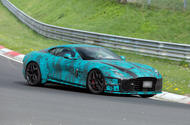New V12 engine gives reborn Vanquish much more power than the DBS
DBS replacement will start a run of specials using new 824bhp V12, which you can listen to here
Aston Martin will reveal the new Vanquish, complete with a thunderous V12, on 2 September.
Its next-generation GT flaghship has been confirmed to pack 824bhp and 738lb ft of torque, which are substantial increases of 109bhp and 74lb ft over the outgoing DBS.
Those figures are significantly higher even than the run-out Ultimate edition of the DBS and will make the Vanquish one of the most powerful production Astons yet, outpunched by only the one-off Victor and the Valkyrie hypercar.
The increase in potency comes courtesy of an extensive redevelopment programme for Aston’s twin-turbocharged V12, the roaring soundtrack of which the company has previewed in a short video (below).
Aston has strengthened the cylinder block, redesigned the cylinder heads and reprofiled the camshafts. There are new intake and exhaust ports, too, and the spark plugs have been moved, which in conjunction with more powerful fuel injectors allows for “optimised combustion”.
The turbochargers, meanwhile, are now more responsive and run at a higher speed, boosting throttle response.
Aston said the new engine will “achieve unprecedented performance and efficiency”, hinting it will make the Vanquish tangibly quicker than the DBS.
The company indirectly confirmed the name of the new car in its affirmation that “all will be vanquished” by the new GT, which will be the first of a run of “exclusive and limited-availability models” to use the overhauled V12.
The engine itself will be handbuilt in “strictly limited numbers”, suggesting the Vanquish will be a much lower-volume proposition than its DBS predecessor.
Chief technical officer Roberto Fedeli said: “The V12 engine has long been a symbol of power and prestige, but it’s also a statement of engineering passion and technical prowess.
“With 824bhp and 738lb ft of torque, this unparalleled engine represents nothing less than the dawn of a dazzling new V12 era for Aston Martin.”
Aston has previously spoken of its intention to transform its flagship GT into a bona fide supercar, more clearly distinguished from its V8-engined Vantage and DB12 siblings.
Spy shots of the Vanquish in testing reveal that it’s based on the DB12 but with a wide-reaching visual makeover that points to its extra grunt: there are huge new vents on the bonnet to keep the 12-cylinder engine cool, a much wider front grille and a chunkier lower splitter that hints at improved downforce.
The rear end features a larger diffuser to improve aerodynamic performance, and the twin-exit exhaust set-up has been replaced with four tailpipes, nodding to the extra cylinders.
The power increase will no doubt be matched by a comprehensive chassis overhaul, building on the set-up deployed on the fearsome DBS 770 Ultimate, with uprated dampers and a boost in rigidity at both ends helping to improve cornering performance and giving the supercar a broader scope of ability on track.
Although it shares its basic bodywork and no doubt some of its platform with the DB12, the Vanquish will be “completely different” to both that GT and the new Vantage, Aston Martin chief creative officer Marek Reichman told Autocar previously.
Crucial to Aston Martin’s desire to cement its status as a maker of top-drawer sports cars as well as more luxury cars will be ensuring that each of its front-engined models has its own distinct character and capabilities.
“Rather than having products with two levels of power output and performance – and that includes dynamics and braking and all the other aspects of what makes a proper performance car – we now have to bring these power levels that give our cars the edge,” said strategy and product boss Alex Long.
Long also emphasised that V12 engines are “synonymous” with Aston Martin. “People still love the twelves,” he said. “As much as the electrification revolution continues, [a V12 engine has] a different use case, and it’s still very much a huge emotional connection for our customers.”
Source: Autocar
